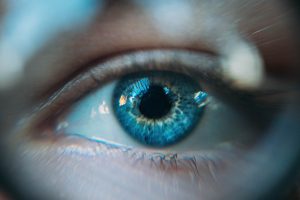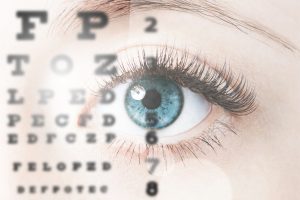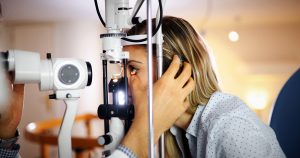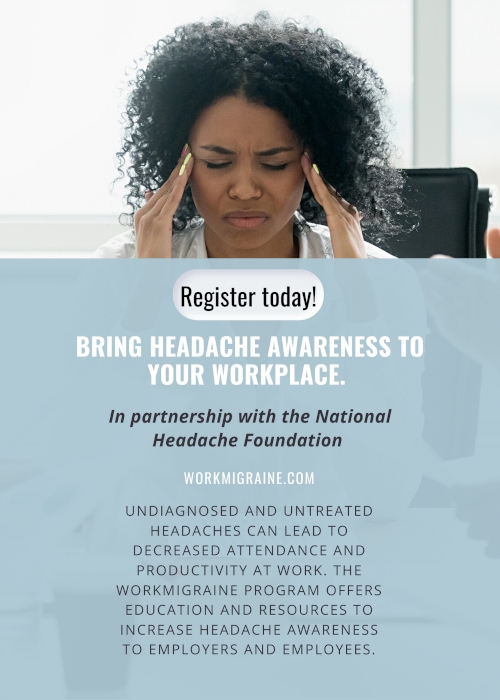How to Bring Headache Awareness to the Workplace
Tuesday, May 11th, 2021
Promoting a happy and healthy work environment is essential to having a productive, prospering workplace. Migraines are a common deterrent to both productivity and attendance in employees. Outside of the general stress or tension headaches that plague many people, over 40 million Americans suffer from the neurological disease of Migraine headaches. Many migraine sufferers remain undiagnosed and untreated. Here are some ways to bring education and awareness to your workplace.
- Education and Treatment Options
According to recent studies, 52% of Migraine sufferers remain undiagnosed. Common over-the-counter treatment medications are insufficient to treat the multiple debilitating symptoms associated with Migraines. These symptoms may include nausea, vomiting, sensitivity to light and sound, and difficulty concentrating. All these things make it extremely difficult to work, leading to absences from work which we refer to as “absenteeism.”
Still, others are afraid of being labeled as unreliable and choose to stay at work amidst their symptoms. This leads to a decreased level of performance and a term we call “presenteeism.” Employees are present in the body at their job, but they are working at far less than optimal capacity. Presenteeism accounts for most of the cost to a company due to headaches.

The National Headache Foundation has created a program called “WorkMigraine” with education modules geared towards Employees, HR, and Employers respectively. These modules and resources are influential in educating individuals on headaches and treatment options. They have the potential to significantly decrease the loss of productivity due to headaches.
2. Omit or Minimize Triggers
Creating an environment that is sensitive to the needs of headache sufferers is a simple way to bring wellness to your workplace. If possible, omit or minimize the following triggers of headaches and migraines:
- Stress – promote a healthy lifestyle and relaxation techniques.
- Noise – minimize loud talking, music or machinery. Provide earplugs if needed.
- Light – flickering fluorescent lights can be problematic. A more indirect light source may be beneficial. Consider encouraging employees to use blue light glasses to help with computer screen glare.
- Odors – enforce a cologne-free workplace. Ensure there is proper airflow and fresh air. Designate a specific area for eating, away from workspaces.
- Posture – use ergonomic chairs and desks. Offer standing desks for those who may benefit from that option.

Some headaches may be avoided by limiting these common triggers. In addition, providing a dark, quiet space for employees who are struggling with headaches may prevent them from getting worse. This can allow an employee to recover quickly and be able to get back to work.
If all else fails, understand that an employee at work suffering from a migraine will not perform well. Encourage them to seek treatment and rest.
3. Have an Open Dialogue
Open communication with your employees is essential to good morale and finding solutions to any problems. When an employee can partner with their employer to come up with a plan, there can be progress. Have an open dialogue with employees about their specific headache triggers. Provide encouragement to seek treatment from a healthcare professional. Go over options for sick days and ways they can make up time they may miss due to their headaches.

Migraine sufferers are not unreliable. They have a neurological disease that needs attention and treatment. It is difficult to see the symptoms of a migraine outwardly, but with open communication, absenteeism and even presenteeism can be lessened and even avoided.
Visit The National Headache Foundation for more information and resources on Headache Awareness and the WorkMigraine program.
Hepatitis: Find The Missing Millions
Thursday, July 2nd, 2020
Every year on July 28th, we observe World Hepatitis Day. This is a day to raise awareness and connect those infected with proper care. It is estimated that nearly 300 million people are walking around infected, completely unaware. The main way to remedy this issue is to spread awareness, encourage people to get tested, and receive treatment.
Prevention
The goal is to eradicate all forms of viral hepatitis by the year 2030. While we’ve seen a decrease in diseases like tuberculosis and HIV, cases of hepatitis have continued to rise. The CDC’s main tool of prevention has been to encourage vaccination. Both hep A and B have vaccines, with hep B being most commonly spread from an infected mother to her child during birth. This is why the hep B vaccination is recommended for infants before leaving the hospital.

Hep C, D, and E do not yet have vaccines. However, hep C can be treated in 90 percent of cases. Hep D is only contracted when an individual is already infected with hep B. So vaccinating against hep B can also protect against hep D.
Types of Hepatitis
Viral hepatitis comprises types A, B, D, D, and E. These are infectious diseases that spread easily from person to person and lead to liver disease.
Hepatitis A – Hep A is rarely fatal, but does cause some serious symptoms. In the US it is spread through close personal contact with someone who is infected. Poor sanitation and hygiene can also lead to its spread worldwide.
Hepatitis B – This virus is the one most commonly spread from mother to infant at birth. This is why it is recommended that all infants receive the vaccine as soon after birth as possible. Hep B can lead to cirrhosis of the liver and liver cancer.
Hepatitis C – There is currently no vaccine for Hep C, although 90% of cases are able to be cured. This virus is usually transferred through infected blood, by the sharing of needles or improper medical treatment. The research for a vaccine is ongoing.
Hepatitis D – Hep D can only be contracted by someone already infected with Hep B. So even though there is no vaccine for it, the best way to prevent it is by being vaccinated for Hep B.
Hepatitis E – Hep E is typically contracted from contaminated drinking water, usually in areas with poor sanitation and water filtration. It is most deadly to pregnant women.

How to Get Tested
So while millions are walking around infected with hepatitis, they are unknowingly endangering themselves and others. We need to get those who are infected tested and connected to treatment. How do you get tested? A simple blood test can be performed by your doctor. This will determine what type of virus you may have as well as its severity. The doctor may also examine your liver to look for signs of inflammation.
Someone can be infected with the virus and not show any symptoms for years. So it’s important to get tested if you fall into any one of these categories:
- Baby boomers (those born between 1945 and 1964) are much more likely to be infected.
- Anyone who has had a blood transfusion or organ transplant prior to 1992
- Anyone who has ever (even once) injected illegal drugs or shared needles.
- People with tattoos.
- Anyone born to someone infected with a hepatitis virus.
Treatment Options
In general, most forms of hepatitis are either treatable or resolve on their own with rest and proper care. For acute hep C and chronic forms of both hep B and C, an antiviral medication may be prescribed. There are no medications available at this time to treat hep D or E. If extensive damage is done to a person’s liver, a liver transplant may be required.

For more in-depth information about hepatitis, its symptoms, and treatment options, please visit the links in our Wellness Observance Calendar. We have the most comprehensive Wellness Calendar available and we offer it to you as a free download for your resource!
Managing Your Allergy Symptoms Naturally
Sunday, March 29th, 2020
Spring is in the air – and so is pollen. It’s that time of year when seasonal allergies are at an all time high. Over the counter allergy medications help, but most of us prefer a natural remedy when we can find one. Sometimes OTC medications just aren’t doing enough to relieve the severity of your symptoms. We have gathered some all natural ideas for you, but be sure to run them by your doctor to make sure they’re the best options for your specific case.

Your Body’s Response to Allergens
Your body senses allergens as a foreign, negative agent that needs attacking! It produces proteins called “histamines” to get to work and eliminate the allergens from your body. These create symptoms in your body like itchy, watery eyes, runny nose, sneezing, scratchy throat even atopic dermatitis. Even though these symptoms are uncomfortable, it’s evidence that your body is doing a good job!
What your body needs to ease these symptoms is anti-histamines and anything that reduces inflammation in the body. If we can reduce inflammation, we can reduce the severity of symptoms. There are plenty of natural agents that combat inflammation and we’ll talk about several.
Reducing Inflammation
There are so many natural aids that deal with inflammation in the body. We’re going to choose just a few to discuss here, but feel free to do your own research on other options you may have.

Vitamin C is everybody’s favorite immune booster, but with good reason! It is one of the most powerful antioxidants, which is incredibly beneficial since allergies create oxidative stress in the body. It’s also an excellent anti-inflammatory and 2 grams of vitamin C daily can act as an anti-histamine. Whether in supplement form or in your diet, make sure you’re getting plenty of Vitamin C to start.
Bromelain is another popular anti-inflammatory. It’s an enzyme found naturally in pineapple, but you can also find it in supplement form. It’s been used as a treatment post surgery, and has been found especially helpful for inflammation in the sinuses.
Probiotics are essential for good gut health and gut health boosts your immune system. But where allergies are concerned, your immune system may be in “hyper-drive” or over reacting. Taking a good probiotic (They are not all created equal. Do your research and consult your doctor.) will help bring balance back to your immune system, reducing inflammation in the body and lessening the body’s overactive immune response.
Milk Thistle & Turmeric are both great liver support. When your body is full of toxins, your liver is working hard and may struggle to eliminate allergens. This may make your allergy symptoms worse. Be kind to your liver by reducing your intake of fatty, fried foods, alcohol and sugar. Taking a supplement containing milk thistle and turmeric can be very beneficial for detoxing your liver and may lead to a decrease in your allergy symptoms.
Eliminating Allergens
We can’t very well stay locked inside all day, every day and most of us don’t want to. But there are some simple ways we can try to eliminate a few of the allergens that trigger symptoms, without lessening our quality of life.
Taking frequent showers, especially after spending extended time outdoors will help to wash away allergens that you are carrying on your body or in your hair. Vacuuming frequently and changing your pillowcase often can also help.
Change your air filter regularly. Invest in a dehumidifier to eliminate extra moisture that may be contributing to any mold or mildew growth in your home. You may also try an air purifier to help eliminate other airborne allergens and improve the overall quality of air that you breathe in your home. Many individuals have seen incredible differences in their allergies from the use of an air purifier.
Nasal irrigation by means of a nettipot or a simple saline spray have also proven very effective at relieving respiratory symptoms. They can help to flush out any allergens residing in your nose and keep things moving along.
Exercise is A Cure All

Studies have shown that exercise has a profound effect on the reduction of allergy symptoms. Although, no one really knows why. One reason may be that it’s a great stress reliever and less stress leads to less overall inflammation. Regardless, the benefits of exercise are so numerous, that you can only be better off by trying it.
Please visit our National Wellness Calendar for more information on Asthma and Allergy Awareness Month coming this May, as well as other Wellness Observances.
COVID-19: What We Need to Know
Saturday, March 14th, 2020
The world has been affected by this coronavirus outbreak in a way that none of us expected a few weeks ago. With the widespread reach of the media and social networks, we have the double-edged sword of a surplus of information. It can be difficult to wade through it all and make sense of what it means. There are two extreme ends of the spectrum, oscillating between extreme panic to an almost blase attitude. There is some real cause for concern, but we’d like to help the situation by compiling some helpful facts and tips for how to handle our current situation.

Preventing the Spread of Disease
The disease has been found to spread most easily from close contact (within 6 feet) from person to person. The transfer of the virus can occur from unprotected coughing or sneezing. The CDC has been extremely clear in describing the measures we can all take to prevent the spread of this highly contagious virus.
- Wash hands frequently, especially after using the bathroom, coughing or sneezing, touching any potentially contaminated surfaces.
- Keep your unwashed hands away from your face where germs can obtain easy entry into your body.
- Stay home when you are sick.
- Keep away from people who are infected with the virus.
- Put distance between yourself and large groups of people if there is a spread in your community.
- Wear a facemask ONLY if you are sick or caring for a sick person who may be unable to wear one.
- Clean and disinfect frequently touched surfaces.

As employers, how can we keep our workplaces healthy?
- Encourage employees to stay home when sick by providing flexible sick leave policies.
- Enable as much work to be done remotely as possible during community outbreaks.
- Separate sick employees who may become sick during the workday.
- Encourage routine hand washing.
- Perform thorough routine cleaning of frequently touched surfaces.
- Educate employees on symptoms or coronavirus.
Symptoms of Coronavirus
The coronavirus is a respiratory illness exhibiting the following symptoms. Keep in mind that people may respond to the virus in different ways. These symptoms may appear up to 14 days after exposure:
- Fever
- Cough
- Shortness of breath
Most cases of the virus have been mild and recoverable. However, there are some who are at increased risk for the most severe cases, potentially becoming fatal. Those at high risk include the elderly and those with preexisting conditions such as heart disease, diabetes, and lung disease. If you or someone close to you fit into the high-risk category, take extra precautions.
If you do exhibit symptoms don’t go to the doctor. Call your doctor and describe your symptoms and possible exposure to the illness. They can advise you if you need to be tested and tell you what your next steps should be.

Be a Kind Human
Remember that we are all in this together. Even if you are not at a high-risk for infection, you may unknowingly be in close contact with people who are. Consider the people around you. Take all the precautions advised by the CDC to prevent or lessen a widespread outbreak in your area.
Be considerate when stocking up on supplies and only purchase what you need. Leave some for others rather than overbuying out of panic or fear.
Keeping Anxiety at Bay
In order to keep anxiety at bay, it may be best to limit your exposure to social media outlets. Protect your mental health by keeping things light, talking to your loved ones and staying focused on the positive. Even though this virus isn’t well known, much progress has been made already. The mass cancellations are for our safety and prevention and should be comforting more than inciting fear. It’s a means of stopping the spread of the virus so that it stays under control.
For much more specific information on the coronavirus and how to stay healthy, especially as businesses and employers, visit the official CDC website.
Oral, Head & Neck Cancer Awareness
Sunday, February 23rd, 2020
In 2020, we observe Oral, Head and Neck Cancer Awareness Week from April 13th-19th. Since 71 percent of Americans have never been examined for these types of cancers, free screenings are offered during the Awareness week. Help us spread awareness by promoting the free screenings and spreading knowledge about symptoms with individuals who may be at risk.
Who is at Risk for Developing Oral, Head and Neck Cancer?

Those at risk include anyone who smokes or uses tobacco. Tobacco use accounts for 85% of all cases of oral, head and neck cancers. Excessive alcohol intake also puts you at risk and the combination of the two increases your risk dramatically.
Human papillomavirus is another common cause of cancer, especially of the throat. Epstein-Barr virus usually remains dormant in infected individuals. It can exhibit itself in the form of mono and has also been associated with nasopharynx cancer.
Men are 2-3 times more likely to develop some form of oral, head or neck cancer than women. Poor nutrition lacking in A and B vitamins can also increase your risk. People with poor dental hygiene are at an increased risk as well as sufferers of GERD (gastroesophageal reflux disease).
Symptoms

Oral, head and neck cancers are found the squamous cells that line the head and neck. Symptoms can exhibit in the form of a lump in these areas. They may also cause a longterm sore throat or persistent fever. Other symptoms include difficulty swallowing and a change in voice.
Any of the above symptoms could also be indicators of a less serious condition. If you have any of these symptoms, it’s best to be seen by a medical professional to determine the exact cause.
Prevention
Early diagnosis is imperative for preventing the development of these cancers. This is why the free screenings offered are so important to take part in. Last year hundreds of free screenings were offered in hospitals and medical centers across the country and the world. Free screenings can be found throughout the year, but the most availability occurs during the awareness week.

Simply ceasing tobacco use is a great way to prevent cancer from developing. Our bodies have the amazing ability to even reverse the damage that has already been done. Younger, healthy individuals have been known to develop oral, head and neck cancers more as a result of HPV. Receiving vaccination against the virus is essential to preventing these cancers.
How To Spread Awareness
Visit the Head and Neck Cancer Alliance to find out more about how to host a free screening event. You can also search for free screening sites near you on their website.
In addition to attending a free screening, there are other events offered like runs, education workshops, galas, and silent auctions. It doesn’t take much to share a social media post or to communicate your own story with your sphere of influence. Do what you can to promote health and oral, head and neck cancer awareness. Together we can save lives.
Age-Related Macular Degeneration
Sunday, December 29th, 2019
What is Age-related Macular Degeneration (AMD)?

Age-related Macular Degeneration is the leading cause of vision loss in Americans aged 50 and over. The macula is located at the back of the retina and controls our central and color vision. Vision impairment from AMD occurs in one of two ways. In dry AMD, protein called drusin gather under the macula and begin to deteriorate the retinal support system. Once the structural support system of the retina has been broken down, it moves into wet AMD. The breaking down of that support allows abnormal blood vessels to grow and potentially leak into the retina, causing a loss of central vision.
Symptoms and Risk Factors of AMD
There are no real symptoms for age-related macular degeneration or low vision until the condition has progressed. Only an examination by your eye doctor can reveal indications before they become a problem. That is why it is so imperative that you get regular eye exams. After the age of 60, schedule exams for every year or as recommended by your doctor. Once the problem is identified, there are measures to take to slow or repair the damage to your vision.

Once you have AMD, you may see a dark spot in the middle of your vision. Lines or outlines of objects will also appear distorted or blurred. Colors may also appear different or faded.
Risk factors include but are not limited to:
- Genetics
- History of smoking
- Being female
- UV Light
- Age (50+)
AMD Treatment Options
The best treatment is always preventative measures. Scheduling regular eye exams will enable your doctor to recognize any issues before they progress. Catching AMD in the early stages leads to treatment by vitamin supplementation. Vitamins C, E, Beta Carotene, Zinc Oxide and Cupric Oxide have been shown to decrease the progression of Macular Degeneration when taken in the early stages.

If you are a smoker and show signs of AMD, the first step is to quit smoking. Then use caution when treating with vitamins since too much beta carotene in smokers has proven to increase the risk for lung cancer.
A healthy diet full of leafy green vegetables is also recommended for treatment.
The treatment for advanced stages of AMD is rapidly developing. There are various treatments that can be recommended by your doctor that focus on slowing the growth of blood vessels. These efforts can put a halt on any additional vision loss.
For additional information and resources on treatments and risk factors, visit our National Wellness Calendar. We’ll observe Age-Related Macular Degeneration Awareness Month this February 2020.
Glaucoma: A Silent Stealer of Vision
Tuesday, November 26th, 2019
What is Glaucoma?
Today we’re going to discuss glaucoma. Glaucoma is a very serious family of eye diseases. There are many types of glaucoma, but they all have three basic characteristics.

- Intraocular pressure, which causes damage to the nerves in the eye: The eye continuously produces a fluid called the aqueous humor. It circulates within the eye and then drains through a structure called the trabecular meshwork. This fluid produces pressure which fills the eye and gives it its shape, much like air in a tire. Normal pressure is between 10 to 21, but some patients can tolerate higher pressures without apparent damage; this is called ocular hypertension, while others can have damaging effects with normal pressure. This is considered low tension glaucoma. This pressure is easily measured. Most patients have had the experience of the air puff tonometer. A more updated version is called a digital tonometer, which very lightly taps the surface of the cornea with a round, painless probe. This is one of many instruments we can use to measure the intraocular pressure. It is a good screening device, but if you are diagnosed with glaucoma, one of the more accurate instruments are used.
- Changes to the optic nerve in the back of the eye: The optic nerve carries all of the information from the photoreceptors to the brain. If it becomes damaged, the signals traveling through it will become less clear, kind of like having bad reception with an antenna. The optic nerve is visible when we look through the pupil with an instrument called an ophthalmascope. It is a round structure directly in the back of the eye. A healthy nerve looks pink in color and has a flat surface, or perhaps a slight depression called the optic cup. In glaucoma, we see a widening and deepening of the depression and the color changes from light pink to white. If the pressure is not reduced to an acceptable level, this process continues until the entire nerve is affected and can become severely and irreversibly damaged. As we said, the nerve is easily seen through the pupil. Sometimes, we will dilate the pupil and take photos of the nerve to document its appearance and have a reference to compare to in the future as needed. Otherwise, we will just take the photo of the retina if it is clearly visible in the photo and skip the dilation so that your eyes will not need to be blurry and light-sensitive for several hours. There are several other instruments available to measure and evaluate the extent of nerve damage and are used if glaucoma is present.
- Peripheral vision loss: When nerve damage has occurred between the eye and the brain, loss of the visual fields may result. Small areas are affected first, in your peripheral vision which the patient doesn’t notice, then larger areas resulting in tunnel vision, and if untreated, eventually total blindness in the eye. Loss of vision in the peripheral fields is the most significant finding in glaucoma and the most diagnostic in relationship to glaucoma. Extensive field loss can be debilitating to the patient, making it hard to perform day to day tasks. Visual fields are measured by instruments called visual field perimeters. They accurately plot a patient’s visual fields and we can see even small defects before they are noticed by the patient. Once plotted, we can use these as a baseline to compare to visual fields taken later. If no progression in field loss is seen we know the patient’s treatment is successful.

Glaucoma is an insidious disease, a silent stealer of vision. The patient has no symptoms, no pain, no visual complaints until the disease has progressed to an advanced state. Early detection is critical in preserving vision because once advanced it is very difficult to prevent further loss. Age, family history of the disease and race are all contributing factors. The mechanisms that cause glaucoma are not known and there is no real cure, only treatment to keep it under control. Treatment usually consists of drops to lower the pressure but some types of glaucoma may require surgical intervention. Yearly eye exams are the best way to catch the disease in an early stage before damage has occurred.
Guest Post Submission from See NC Eyecare. Visit them for all your vision needs in the Raleigh, NC Triangle Area.![]()



